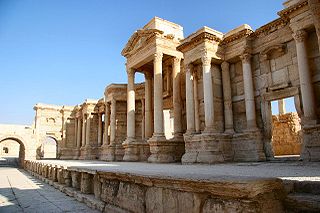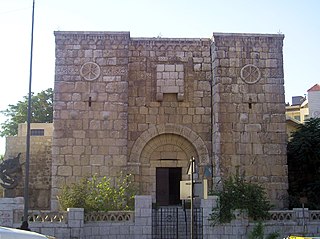The 630s decade ran from January 1, 630, to December 31, 639.

Year 633 (DCXXXIII) was a common year starting on Friday of the Julian calendar. The denomination 633 for this year has been used since the early medieval period, when the Anno Domini calendar era became the prevalent method in Europe for naming years.

Year 637 (DCXXXVII) was a common year starting on Wednesday of the Julian calendar. The denomination 637 for this year has been used since the early medieval period, when the Anno Domini calendar era became the prevalent method in Europe for naming years.
Osric was a King of Deira in northern England. He was a cousin of king Edwin of Northumbria, being the son of Edwin's uncle Æthelric of Deira. Osric was also the father of Oswine.

The Battle of the Yarmuk was a major battle between the army of the Byzantine Empire and the Arab Muslim forces of the Rashidun Caliphate. The battle consisted of a series of engagements that lasted for six days in August 636, near the Yarmouk River, along what are now the borders of Syria–Jordan and Syria-Israel, southeast of the Sea of Galilee. The result of the battle was a decisive Muslim victory that ended Roman rule in Syria after about seven centuries. The Battle of the Yarmuk is regarded as one of the most decisive battles in military history, and it marked the first great wave of early Muslim conquests after the death of the Islamic prophet Muhammad, heralding the rapid advance of Islam into the then-Christian/Roman Levant.

The Muslim conquest of Persia, also called the Muslim conquest of Iran, the Arab conquest of Persia, or the Arab conquest of Iran, was a major military campaign undertaken by the Rashidun Caliphate between 632 and 654. As part of the early Muslim conquests, which had begun under Muhammad in 622, it led to the fall of the Sasanian Empire and the eventual decline of Zoroastrianism, which had been predominant throughout Persia as the nation's official religion. The persecution of Zoroastrians by the early Muslims during and after this conflict prompted many of them to flee eastward to India, where they were granted refuge by various kings.

The Battle of Ajnadayn was fought in July or August 634, in a location close to Beit Guvrin in the Roman-era Palestine region; it was the first major pitched battle between the Byzantine (Roman) Empire and the army of the Arab Rashidun Caliphate. The result of the battle was a decisive Muslim victory. The details of this battle are mostly known through Muslim sources, such as the ninth-century historian al-Waqidi.
The Battle of the River, also known as Battle of Al Madhar, took place in Mesopotamia between the forces of the Rashidun Caliphate and the Sasanian Empire. Muslims, under Khalid ibn al-Walid's command, defeated the numerically superior Sasanian army.

The Battle of Walaja was fought in Mesopotamia in May 633 between the Rashidun Caliphate army under Khalid ibn al-Walid and Al-Muthanna ibn Haritha against the Sassanid Empire and its Arab allies.

The Muslim conquest of the Levant, or Arab conquest of Syria, was a 634–638 CE invasion of Byzantine Syria by the Rashidun Caliphate. A part of the wider Arab-Byzantine Wars, the Levant was brought under Arab Muslim rule and developed into the provincial region of Bilad al-Sham. Clashes between the Arabs and Byzantines on the southern Levantine borders of the Byzantine Empire had occurred during the lifetime of Muhammad, with the Battle of Muʿtah in 629 CE. However, the actual conquest did not begin until 634, two years after Muhammad's death. It was led by the first two Rashidun caliphs who succeeded Muhammad: Abu Bakr and Umar ibn al-Khattab. During this time, Khalid ibn al-Walid was the most important leader of the Rashidun army.

The Battle of Ullais was fought between the forces of the Rashidun Caliphate and the Sasanian Persian Empire in the middle of June 633 AD in Iraq, and is sometimes referred to as the Battle of Blood River since, as a result of the battle, there were enormous amounts of Persian Sasanian and Arab Christian casualties.
Battle of al-Qaryatayn was a minor battle between the Christian Ghassanid Arab allies of the Byzantine Empire, and the Rashidun Caliphate army. It was fought after Khalid ibn al-Walid had conquered Tadmur in Syria. His army marched to al-Qaryatayn, the inhabitants of which resisted the Muslim army. They were fought, defeated and plundered. This resulted in the conquest of Al-Qaryatayn by the Muslim forces.

The Battle of Bosra was fought in 634 CE between the Rashidun Caliphate army and the Byzantine Empire over the possession of the city of Bosra, in Syria. The city was one of the Islamic forces' first significant captures and was at the time the capital of the Ghassanids, Arab vassals of the Byzantines. The siege took place between June and July.

The Battle of the Iron Bridge was fought between the Muslim Rashidun army and the Byzantine army in 637 AD. The battle took its name from a nearby nine-arch stone bridge spanning the Orontes River which had gates trimmed with iron. It was one of the last battles fought between the Byzantines and Rashidun Caliphate in the province of Syria. The aftermath of the battle marked the nearly complete annexation of the province into the Rashidun Caliphate with the fall of its capital, Antioch.

The Rashidun Caliphate consisted of the first four successive caliphs (lit. 'successors') — Abu Bakr, Umar, Uthman, and Ali — who led the Muslim community/polity from the death of the Islamic prophet Muhammad in 632, to the establishment of the Umayyad Caliphate in 661. The Caliphate's first 25-years were characterized by rapid military expansion during which it was the most powerful economic, cultural, and military force in West Asia and Northeast Africa. By the 650s, in addition to the Arabian Peninsula, the caliphate had subjugated the Levant to the Transcaucasus in the north; North Africa from Egypt to present-day Tunisia in the west; and the Iranian Plateau to parts of Central and South Asia in the east. The caliphate ended in a five-year period of internal strife. The title Rashidun comes from the belief in Sunni Islam that the caliphs were 'rightly guided', and therefore constituted a religious model to be followed and emulated. The caliphs are also known in Muslim history as the "orthodox" or "patriarchal" caliphs.

The siege of Damascus (634) lasted from 21 August to 19 September 634 before the city fell to the Rashidun Caliphate. Damascus was the first major city of the Eastern Roman Empire to fall in the Muslim conquest of Syria.
Battle of Marj al-Dibaj was fought between the Byzantine army, survivors from the conquest of Damascus, and the Rashidun Caliphate army in September 634. It was a successful raid after three days of armistice, on the Byzantine survivors of the conquest of Damascus.
The siege of Germanicia or Marash was led by Muslim forces of the Rashidun Caliphate during their campaigns in Anatolia in 638. The city surrendered without much bloodshed. The expedition is considered significant due to the fact that it marked the end of the military career of the Arab Muslim general Khalid ibn Walid, who was dismissed from the army a few months after his return from the expedition.

The Arab conquest of Mesopotamia was carried out by the Rashidun Caliphate from 633 to 638 AD. The Arab Muslim forces of Caliph Umar first attacked Sasanian territory in 633, when Khalid ibn al-Walid invaded Mesopotamia, which was the political and economic centre of the Sasanian state. From 634 to 636 AD, following the transfer of Khalid to the Byzantine front in the Levant, the hold of Arab forces on the region weakened under the pressure of Sasanian counterattacks. A second major Arab offensive in 636 and ended in January 638 with the capture of Mosul and the consolidation of Arab control over and exclusion of Sasanid influence from the whole Mosul-Tikrit region.
The Battle of Marj ar-Rum, also known as the Battle of Marj Dimashq, was a conflict between the Rashidun caliphate and the Byzantine Empire. The battle occurred shortly after the Battle of Fahl when the Byzantines attempted to recapture Damascus. Heraclius, the Byzantine emperor, sent two separate forces in the effort, one army led by Theodore the Patricius and a second army led by Shannash al-Rome. The Rashidun army led by Abu Ubaydah ibn al Jarrah and Khalid ibn al-Walid was ordered to assist Yazid ibn Abi Sufyan who was acting as the garrison commander of Damascus.














